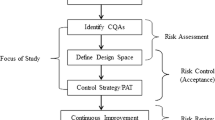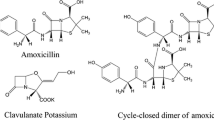Abstract
The purpose of this research was to apply near-infrared (NIR) spectroscopy with chemometrics to predict the change of pharmaceutical properties of antipyrine granules during granulation by regulation of the amount of water added. The various kinds of granules (mean particle size, 70–750 μm) were obtained from the powder mixture (1 g of antipyrine, 6 g of hydroxypropylcellulose, 140 g of lactose, and 60 g of potato starch) by regulation of the added water amount (11–19 wt/wt%) in a high-speed mixer. The granules were characterized by mean particle size, angle of repose, compressibility, tablet porosity, and tablet hardness as parameters of pharmaceutical properties. To predict the pharmaceutical properties, NIR spectra of the granules were measured and analyzed by principal component regression, (PCR) analysis. The mean particle size of the granules increased from 81 μm to 650 μm with an increase in the amount of water, and it was possible to make larger spherical granules with narrow particle size distribution using a high-speed mixer. Angle of repose, compressibility, and porosity of the tablets decreased with an increase of added water, but tablet hardness increased. The independent calibration models to evaluate particle size, angle of repose, and tablet porosity and hardness were established by using PCR based on NIR spectra of granules, respectively. The correlation coefficient constants of calibration curves for prediction of mean particle size, angle of repose, tablet porosity, and tablet hardness were 0.9109, 0.8912, 0.7437, and 0.8064, respectively. It is possible that the pharmaceutical properties of the granule, such as mean particle size, angle of repose, tablet porosity, and tablet hardness, could be predicted by an NIR-chemometric method.
Similar content being viewed by others
References
Otsuka M, Gao J, Matsuda Y. Effect of amount of added water during extrusion-spheronization process of pharmaceutical properties of granules. Drug Dev Ind Pharm. 1994;20:2977–2992.
Terashita K, Ohike A, Kato M, Miyanami K. Granulation process and end-point in high speed mixer granulation. Yakugaku Zasshi. 1987;107:377–383.
Aoki S, Okamoto A, Nemoto M, Yoshida T, Danjjo K, Sunada H, Otsuka A. Optimization of granulation in a vertical high-speed mixer: effect of process variables on mean granule diameter and its distribution. Yakuzaigaku. 1993;53(3):194–199.
Sunada H, Hoshi N, Hasegawa M. Standard Formulation Research Association. Particulate Des Pharm Technique. 1993;213–222.
Toyoshima S, Watanabe S, Matsuo K, Ksai M. Studies on wet granulation, I: the effect of amount of binder on granulating state and properties of granules. Yakugaku Zasshi. 1971;91:1088–1091.
Horisawa E, Yamada M, Danjyo K, Otsuka A. Effect of binder solution on properties of wet masses and granules prepared by extruding granulation. Yakuzaigaku. 1992;52(1):13–24.
Kristensen HG, Holm P, Jaegerskou A, Schaefer T. Granulation in high speed mixers, IV: effect of liquid saturation on the agglomeration. Pharm Ind. 1984;46:763–767.
Ueda H, Ueda J, Sato T. Relationship between water-holding capacity of powder and physical properties of granules prepared by agitating granulation. J Soc Powder Technol Japan. 2001;38:84–89.
Holm P, Jungersen O, Schaefer T, Kristensen HG. Granulation in high speed mixters, II effects of process variables during keading. Pharm Ind. 1983;45:806–811.
Holm P, Jungersen O, Schaefer T, Kristensen HG. Granulation in high speed mixers, II: effects of process variables during kneading. Pharm Ind. 1984;46:97–101.
Jaegerskou A, Holm P, Schaefer T, Kristensen HG. Granulation in high speed mixers, III: effects of process variables on the intragranular porosity. Pharm Ind., 1984;46:310–314.
Iwamoto M, Kawano S, Uozumi J. Introduction of Near-Infrared Spectroscopy. Tokyo, Japan: Saiwai Shobou; 1994.
Martents H, Næs T. Multivariate Calibration. New York, NY: John Wiley & Sons; 1989.
Morisseau KM, Rhodes CT. Near-infrared spectroscopy as a nondestructive alternative to conventional tablet hardness testing. Pharm Res. 1997;14:108–111.
Drennen JK Lodder RA. Nondestructive near-infrared analysis of intact tablets for determination of degradation products. J Pharm Sci. 1990;79:622–627.
Buchanan BR, Baxter MA, Chen TS, Qin XZ, Robinson PA. Use of near-infrared spectroscopy to evaluate an active in a film coated tablet. Pharm Res. 1996;13:616–621.
Norris T, Aldridge PK, Sekulic SS. Determination of end-points for polymorph conversions of crystalline organic compounds using on-line near-infrared spectroscopy. Analyst. 1997;122:549–552.
Saver RW, Meulman PA, Bowerman DK, Havens JL. Factor analysis of infrared spectra for solid-state forms of delavirdine mesylate. Int J Pharm. 1998;167:105–120.
Patl AD, Luner PE, Kemper MS. Quantitative analysis of polymorphs in binary and multi-component powder mixtures by near-infrared reflectance spectroscopy. Int J Pharm. 2000;206:63–74.
Otsuka M, Kato F, Matsuda Y. Comparative evaluation of the degree of indomethacin crystallinity by chemoinfometrical Fourier-transformed near-infrared spectroscopy and conventional powder X-ray diffractometry. AAPS Pharm Sci. 2000;2:article 9.
Otsuka M, Kato F, Matsuda Y. Determination of indomethacin polymorphic contents by chemometric near-infrared spectroscopy and conventional powder X-ray diffractometry. Analyst. 2001;126:1578–1582.
Bull CR. Compensation for particle size effects in near infrared reflectance. Analyst. 1991;116:781–786.
Aucott LS, Garthwaite PH. Transformations, to reduce the effect of particle size in near-infrared spectra. Analyst. 1988;113:1849–1854.
Norris KH, Williams PC. Optimization of mathematical treatments of raw near-infrared signal in the measurement of protein in hard red spring wheat, I: influence of particle size. Cereal Chem. 1984;61:158–165.
Franke P, Gill I, Luscombe CN, Rudd DR, Waterhouse J, Jayasooriya A. Near-infrared mass median particle size determination of lactose monohydrate: evaluating several chemometric approaches. Analyst. 1998;123:2043–2046.
Author information
Authors and Affiliations
Corresponding author
Rights and permissions
About this article
Cite this article
Otsuka, M., Mouri, Y. & Matsuda, Y. Chemometric evaluation of pharmaceutical properties of antipyrine granules by near-infrared spectroscopy. AAPS PharmSciTech 4, 47 (2003). https://doi.org/10.1208/pt040347
Received:
Accepted:
DOI: https://doi.org/10.1208/pt040347




